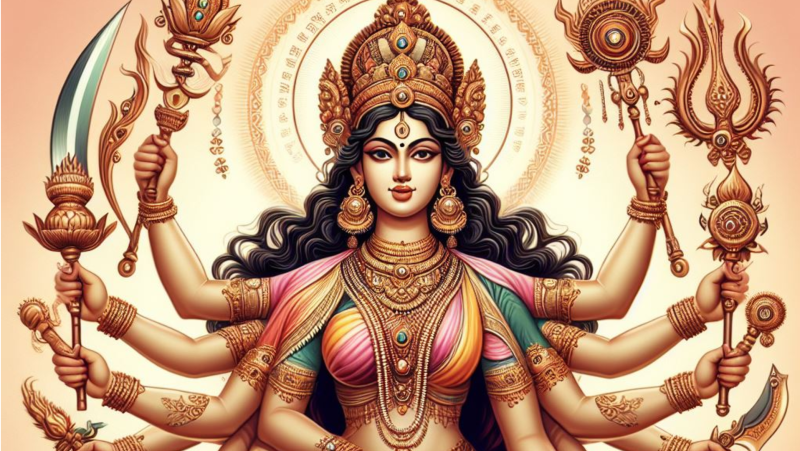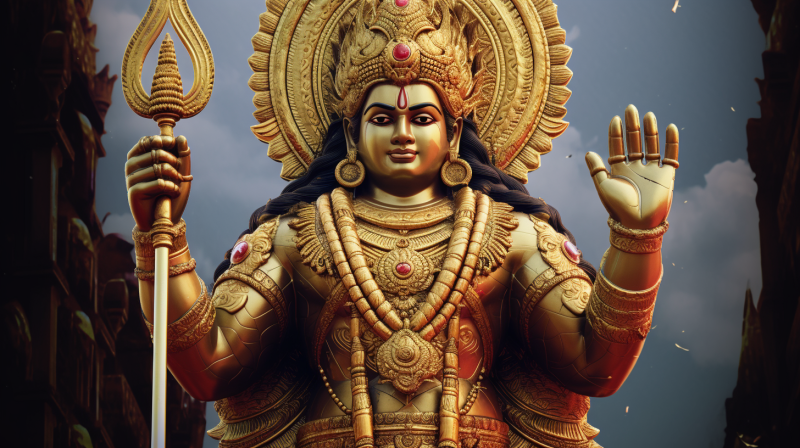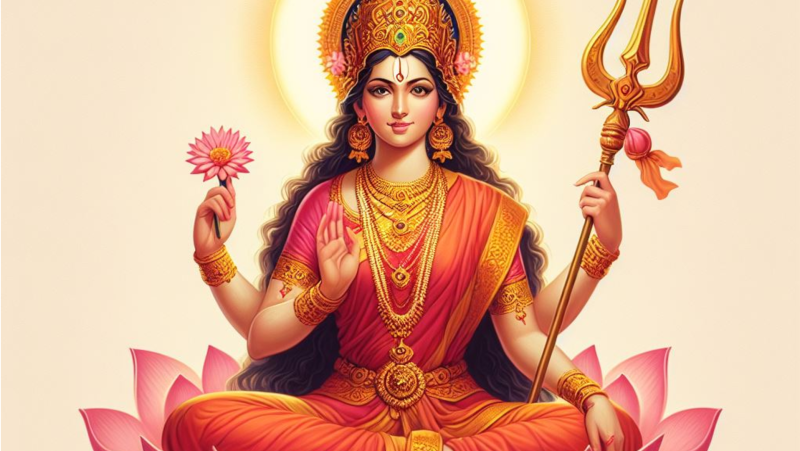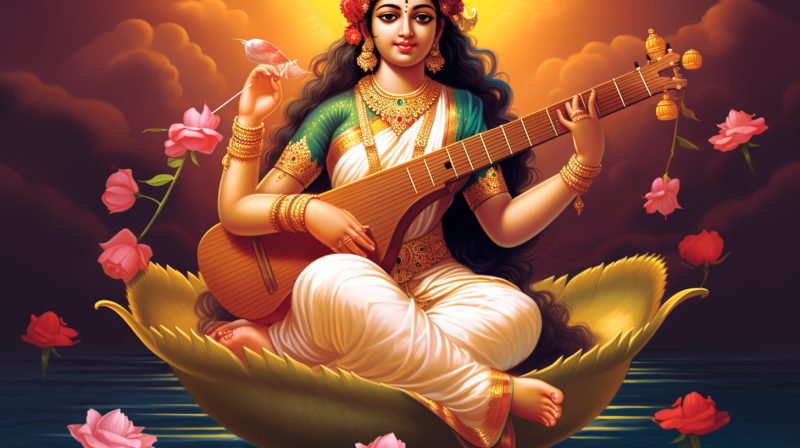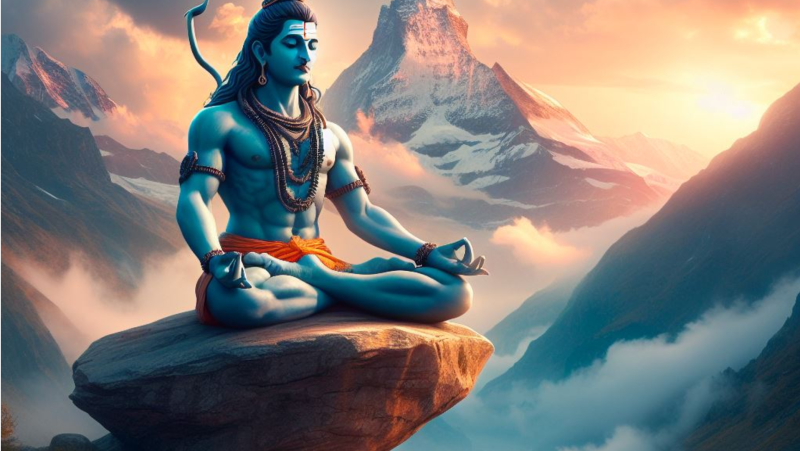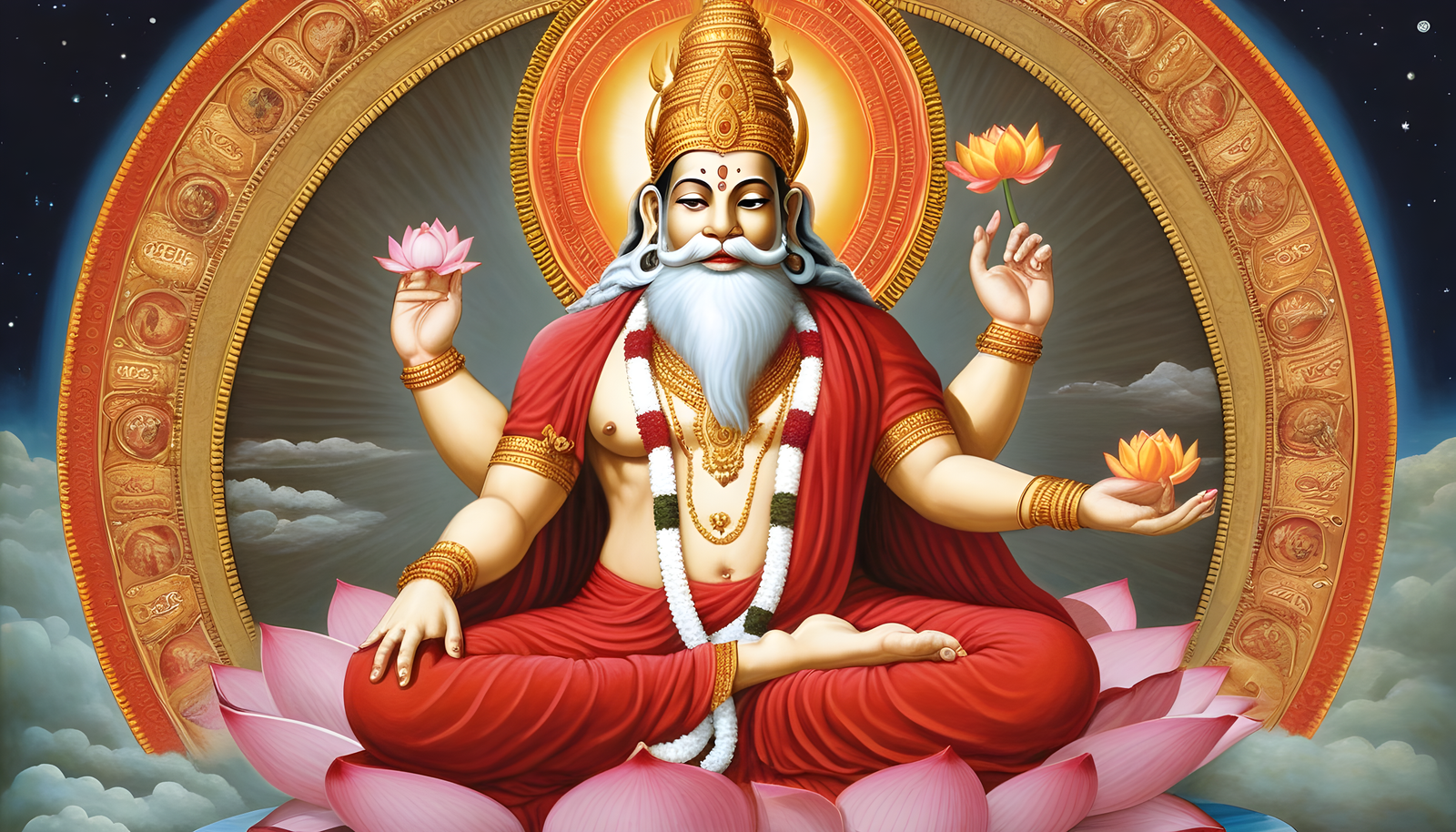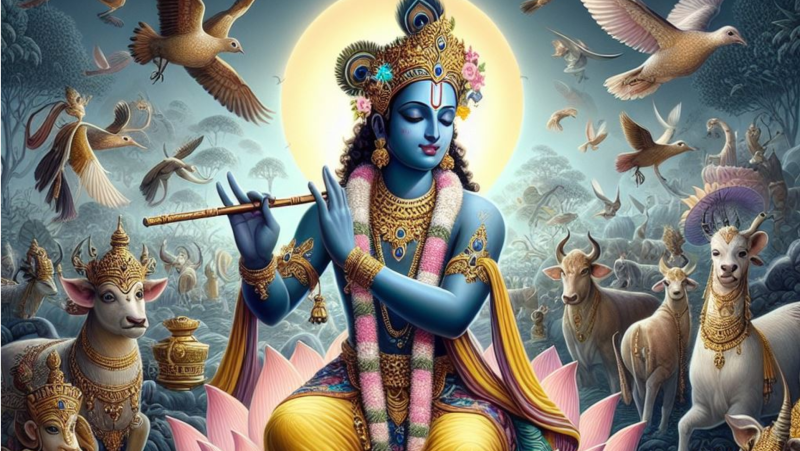
Lord Krishna is one of the most revered and popular deities in Hinduism. He is considered the eighth incarnation (avatar) of Lord Vishnu, one of the principal deities in the Hindu pantheon. The life and teachings of Lord Krishna are described in great detail in various Hindu scriptures, with the most comprehensive account found in the ancient epic, the Bhagavad Gita. Here is a detailed overview of Lord Krishna:
Lord Krishna Birth
The birth of Lord Krishna, one of the most revered deities in Hinduism, is a cherished and significant event in Hindu mythology. It is celebrated as Krishna Janmashtami, a major Hindu festival. The story of Lord Krishna's birth is found in various Hindu scriptures, with the most detailed accounts in the Bhagavata Purana and the Harivamsa. Here's a detailed explanation of Lord Krishna's birth:
Background and Prophetic Prediction:
1. Parents: Lord Krishna was born to King Vasudeva and Queen Devaki. Devaki was the sister of King Kansa, who ruled the city of Mathura.
2. Prophecy: Before Krishna's birth, a prophecy foretold that the eighth child of Devaki would be the cause of Kansa's downfall and death. This prophecy created fear and anxiety in Kansa's heart, leading to his cruelty towards Devaki and Vasudeva.
Imprisonment of Devaki and Vasudeva:
1. Fear and Cruelty: Due to the prophecy, Kansa imprisoned his sister Devaki and her husband Vasudeva in a dungeon. He decided to kill each of Devaki's children as they were born to prevent the prophecy from coming true.
The Divine Birth of Lord Krishna:
1. The Night of Krishna's Birth: On the night of Lord Krishna's birth, the entire universe seemed to be filled with divine anticipation. The atmosphere was charged with spiritual energy.
2. Miraculous Events: Several miraculous events occurred around the time of Krishna's birth:
• The prison doors, which were securely locked, opened on their own.
• The guards fell asleep, and a deep slumber enveloped the entire prison.
• The divine abode of Lord Vishnu in the spiritual realm, known as Vaikuntha, sent forth Lord Vishnu himself, along with his divine energy, to be born as Krishna.
3. Krishna's Appearance: In the prison cell, Devaki and Vasudeva saw the divine form of Lord Krishna. He appeared with a dark complexion (hence the name "Krishna," which means "dark" or "black") and four arms, holding a conch shell (shankha), discus (chakra), mace (gada), and lotus flower (padma). He wore divine ornaments and radiated immense divine splendor.
4. Vasudeva's Journey: Following divine guidance, Vasudeva carried the infant Krishna in a small basket and began a perilous journey to cross the flooded Yamuna River. The river parted to allow Vasudeva to safely reach the village of Gokul. There, he exchanged Krishna for a baby girl (who was actually an incarnation of the goddess Mahakali). This exchange ensured that Kansa remained unaware of Krishna's birth.
Early Life And Childhood of Lord Krishna
The early life and childhood of Lord Krishna, one of the most beloved deities in Hinduism, are filled with enchanting and divine events. Krishna's childhood is primarily associated with his time in the pastoral village of Vrindavan. Here is a detailed explanation of Lord Krishna's early life and childhood:
1. Upbringing in Vrindavan:
• Adoptive Parents: After his miraculous birth in Mathura, Lord Krishna was raised by Nanda and Yashoda, a cowherd couple, in the village of Vrindavan. He grew up as their beloved son, unaware of his divine origins.
• Playful and Charming: Lord Krishna's childhood was marked by his playful and mischievous nature. He was known for his captivating smile and charismatic personality. His playful antics endeared him to everyone in Vrindavan.
2. Krishna's Divine Feats:
• Stealing Butter: Krishna earned the nickname "Makhan Chor" or "butter thief" because of his love for stealing butter from the homes of the villagers. His playful acts of butter theft are celebrated in numerous stories and songs.
• Playing the Flute: Lord Krishna was a master flutist, and the sound of his flute was said to be so enchanting that it attracted not only the people of Vrindavan but also the animals and even the trees. The flute symbolizes his ability to draw souls towards the divine.
• Rasalila: One of the most famous episodes of Krishna's childhood is the Rasalila, a divine dance in which he danced with the gopis (cowherd girls) under the moonlit sky of Vrindavan. This dance represents the deep spiritual connection between the individual soul and the divine.
3. Govardhan Puja:
• Krishna performed a remarkable feat by lifting the Govardhan Hill with the little finger of his left hand to protect the villagers of Vrindavan from the wrath of Lord Indra, the god of rain. This event is known as the Govardhan Puja and symbolizes the importance of worshiping nature.
4. Defeating Demons:
• Even as a child, Lord Krishna displayed his divine powers by defeating various demons and evil forces sent by his uncle Kansa to kill him. Some of these demons included Putana, Trinavarta, Bakasura, and the serpent Kaliya.
5. Divine Relationships:
• Lord Krishna had a special bond with Radha, a gopi (cowherd girl), and is often portrayed as her divine lover. Their love symbolizes the union of the individual soul (Atman) with the divine (Brahman).
• Krishna also had close friendships with other gopis, cowherd boys, and animals in Vrindavan. His divine love and compassion touched the hearts of all who encountered him.
6. Lessons in Dharma and Spirituality:
• While engaging in his playful activities, Krishna imparted profound spiritual and ethical teachings to those around him. His teachings are found in various texts, including the Bhagavad Gita, where he imparts wisdom to Arjuna on the battlefield of Kurukshetra.
The stories of Lord Krishna's early life and childhood, often referred to as "Krishna Leela," are cherished in Hindu tradition and have been celebrated in art, music, and literature for centuries. They serve as a source of inspiration and devotion for millions of people, highlighting the divinity of Lord Krishna and the timeless lessons he imparted through his playful and loving interactions with the world.
Youth and Adolescence of Lord Krishna
The youth and adolescence of Lord Krishna are marked by various significant events and teachings, as detailed in Hindu scriptures like the Mahabharata, Bhagavad Gita, and the Bhagavata Purana. This period in Lord Krishna's life is characterized by his role as a prince, a philosopher, and a guide to his devotees. Here's a detailed explanation of the youth and adolescence of Lord Krishna:
1. Education and Training:
• Mathura Palace: During his youth, Lord Krishna lived in the royal palace of Mathura, the capital city of the Yadava kingdom, under the care of his foster parents, Nanda and Yashoda. However, he was aware of his divine heritage.
• Mentors: Krishna received education from various sages and scholars, including Sandipani Muni, who taught him subjects like mathematics, politics, and the Vedas.
• Mastery of Martial Arts: He excelled in various martial arts, including archery and sword fighting, under the guidance of his tutors. He also became skilled in diplomacy and statesmanship.
2. Defeat of Kansa:
• One of the primary missions of Lord Krishna's youth was to rid the world of the tyrannical rule of his uncle, King Kansa. In a dramatic event, Krishna challenged and defeated Kansa, liberating his parents, Vasudeva and Devaki, from imprisonment.
3. Role in the Mahabharata:
• Lord Krishna played a crucial role in the epic Mahabharata. He served as a charioteer and guide to Prince Arjuna during the Kurukshetra War. It was on the battlefield of Kurukshetra that Lord Krishna imparted profound spiritual and philosophical teachings to Arjuna, which are compiled in the Bhagavad Gita.
4. The Bhagavad Gita:
• The Bhagavad Gita, a 700-verse scripture within the Mahabharata, captures the essence of Lord Krishna's teachings to Arjuna. In this sacred text, Krishna imparts wisdom on various aspects of life, duty (dharma), devotion, and the path to spiritual realization.
• He emphasizes the importance of selfless action (karma yoga), devotion (bhakti yoga), and knowledge (jnana yoga) as means to attain spiritual enlightenment and union with the divine.
5. Divine Exploits and Leelas:
• Even during his youth, Lord Krishna continued to engage in divine exploits and miracles, including lifting the Govardhan Hill, defeating powerful demons like Shishupala and Jarasandha, and performing various divine pastimes (leelas) with his devotees.
6. Spiritual and Philosophical Teachings:
• Krishna's youth and adolescence are marked by his profound philosophical and spiritual teachings, which transcend the boundaries of age. He emphasized the importance of devotion, love, and surrender to God as the most direct paths to liberation.
7. Devotion to Radha:
• Lord Krishna's divine love and devotion to Radha, his beloved gopi, are also a significant aspect of his youth. Their love story is celebrated in various devotional texts and is seen as a symbol of the soul's longing for union with the divine.
8. Cultural and Spiritual Legacy:
• Lord Krishna's teachings and life experiences have left a lasting impact on Indian culture, spirituality, and philosophy. His stories, especially those from his youth, continue to be a source of inspiration for millions of devotees.
The youth and adolescence of Lord Krishna represent a period of divine guidance, wisdom, and transformative experiences that continue to inspire people on their spiritual journeys. His teachings in the Bhagavad Gita are considered timeless and provide valuable insights into the path of righteousness and spiritual realization.
Lord Krishna Marriage
Lord Krishna's marriage is a subject of great significance and is described in various Hindu scriptures, with the most detailed accounts found in texts like the Bhagavata Purana. Krishna is believed to have married several women, but his most well-known and prominent marriages are with Rukmini and Satyabhama. Here's an explanation of Lord Krishna's marriages:
1. Marriage to Rukmini:
• Background: Rukmini was the princess of Vidarbha, and she was deeply devoted to Lord Krishna. She had heard about Krishna's divine qualities, and her heart was set on marrying him.
• Rukmini's Concern: Rukmini's brother, Rukmi, was strongly opposed to her marriage to Krishna. He had arranged for her to marry Shishupala, a prince who was hostile to Krishna.
• Krishna's Arrival: On the day of her wedding to Shishupala, Rukmini sent a letter to Krishna, expressing her love for him and her desire to be with him. In response, Krishna immediately left for Vidarbha to rescue her.
• Rescue and Marriage: Krishna arrived in Vidarbha and, with Rukmini's consent, kidnapped her during the wedding ceremony. He then married Rukmini, and they returned to Dwarka together.
2. Marriage to Satyabhama:
• Background: Satyabhama was a princess and one of Krishna's queens in Dwarka. She was known for her beauty and strong-willed nature. She had a deep love and devotion for Krishna.
• Krishna's Bond with Satyabhama: Satyabhama shared a special relationship with Krishna, and their marriage is often portrayed as a union of love and devotion.
• Participation in Divine Leelas: Satyabhama actively participated in various divine exploits and adventures alongside Krishna, including the recovery of the divine wish-fulfilling jewel known as the Syamantaka gem.
3. Marriages to Other Queens:
• In addition to Rukmini and Satyabhama, Lord Krishna is believed to have married several other queens and princesses during his time in Dwarka. The exact number of his wives varies in different texts, with some sources listing 16,000 or even 16,108 queens.
• Many of these marriages were for various political and strategic reasons, including alliances with other kingdoms and the protection of dharma.
4. Marital Life in Dwarka:
• Krishna's marital life in Dwarka is described as harmonious and blissful. He treated all his queens with love and respect and maintained separate palaces for each of them.
• Despite his numerous marriages, Krishna is considered a symbol of divine love and compassion. His relationship with each queen is seen as a manifestation of his divine love for all beings.
Krishna's marriages, particularly his union with Rukmini and Satyabhama, symbolize the devotion of the individual soul (Atman) to the divine (Brahman). His marriages serve as an allegorical representation of the soul's yearning for a spiritual union with the Supreme Being. Krishna's teachings on love, devotion, and the path to spiritual realization are central aspects of his divine message and continue to inspire millions of devotees.
How Lord Krishna Died
The death of Lord Krishna, one of the most revered deities in Hinduism, is a subject of profound significance and is described in various Hindu scriptures, including the Mahabharata and the Bhagavata Purana. Lord Krishna's death is not portrayed as a conventional mortal passing but rather as a divine and conscious departure from the earthly realm. Here's an explanation of how Lord Krishna's departure is described in Hindu tradition:
1. Context - The Kurukshetra War:
• Lord Krishna played a pivotal role as the charioteer and guide to Prince Arjuna during the Kurukshetra War, a great conflict between the Pandavas and the Kauravas. His teachings to Arjuna on the battlefield are recorded in the Bhagavad Gita.
2. Cessation of the War:
• The Kurukshetra War concluded with the victory of the Pandavas, who emerged as the rightful rulers of the Kuru kingdom. However, the war was a devastating event with immense loss of life.
3. Departure of Lord Krishna:
• After the war, Lord Krishna returned to Dwarka, his capital city, where he resumed his life as a king.
• Lord Krishna knew that the end of his earthly incarnation was approaching, as it was a part of the divine plan.
4. The Sign of a Hunter's Arrow:
• One day, while Krishna was resting under a tree in a forest near Dwarka, a hunter named Jara mistook Krishna's foot for a deer's ear and shot an arrow, unknowingly wounding the Lord.
• Recognizing Lord Krishna's divinity, the hunter was filled with remorse and sought forgiveness from the wounded Krishna.
5. Departure to the Spiritual Realm:
• Lord Krishna, knowing that his time had come, forgave Jara and, in a divine display of his true form, left his mortal body. His divine form ascended to the spiritual realm, marking the end of his earthly incarnation.
6. Symbolic Significance:
• Lord Krishna's departure is seen as a conscious and divine act. It is believed that he chose the moment and circumstances of his departure to teach important spiritual lessons.
• His departure emphasizes the impermanence of the physical body and the eternal nature of the soul (Atman). It also underscores the idea that the divine, being beyond the limitations of the physical world, is never subject to birth or death.
7. Impact on His Devotees:
• The departure of Lord Krishna left a deep impact on his devotees, especially the residents of Dwarka and the Pandavas. They were filled with grief at his physical absence but continued to feel his presence in their hearts.
8. Legacy and Worship:
• Lord Krishna's teachings, divine pastimes, and the Bhagavad Gita continue to guide and inspire millions of people worldwide. His divine legacy is celebrated through various festivals, devotional practices, and temples dedicated to him.
9. Belief in His Eternal Presence:
• While Lord Krishna's earthly incarnation may have concluded, his devotees believe that he eternally resides in the hearts of those who seek his guidance and love. His spiritual presence continues to provide solace and inspiration to those on the path of devotion and righteousness.
In summary, Lord Krishna's departure from the mortal realm is viewed as a divine and conscious event, symbolizing the transcendence of the physical body and the eternal nature of the divine presence. His teachings and legacy continue to be cherished and celebrated in Hinduism and beyond.
You may also like …
Are You The Proud Hindu?
The Trimurti
Create an account to join us and start taking part in conversations.
SIGNIN